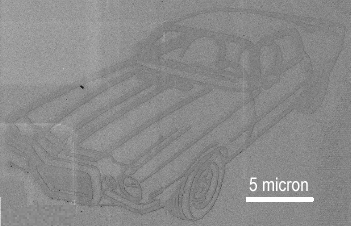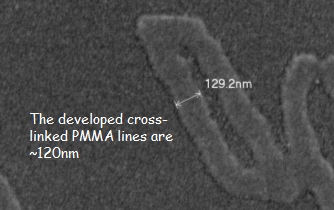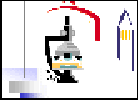
Contact Info
Adam P. Hitchcock
Canada Research Chair
in Materials Research
CLS-CCRS
B.I.M.R
McMaster University
Hamilton, ON
Canada L8S 4M1
V: +1 905 525-9140
x24729
F: +1 905 521-2773
E: aph@mcmaster.ca
U: unicorn.mcmaster.ca
__________
Research
Group
Opportunities
Publications
Links
_____________

X-ray
patterning of sub-100 nm spatial features
WHO: Adam Leontowich, Adam Hitchcock, Harald Stover
Chemistry
& BIMR, McMaster University
WHERE: Advanced & Canadian Light Source Scanning
Transmission X-ray Microscope (STXM)
WHEN: Feb 2009
POSTED: 14 April 2009, mod 29-Sep-09
WHAT: Use of chemical development pushes STXM-based patterning to better spatial resolution
While the PhD thesis research of Jian Wang [1,2] showed that tunable
synchrotron light in a STXM can generate chemically selective patterns
inmulti-layer polymer structures, the spatial resolution achieved
was 150 nm or worse, due to radiation damage spreading mechanism.

However, if patterns are generated in PMMA by STXM and then chemically
developed, much higher spatial resolution caan be achieved. Fig.
1 shows a cartoon of a 1972 Camaro written in PMMA on a 20x40 micron
template, chemically developed and imaged with SEM. Features are
sharp at the spatial resolution of the STXM (30 nm), as shown in
Fig 2.
Since then a further signifcant improvement in spatial resolution has been achieved.
OTHER INFORMATION: Chemically selective patterning has been
described in:
1. J. Wang, H.D.H. Stöver, A.P. Hitchcock and T. Tyliszczak. Chemically
selective soft X-ray patterning of polymers, J. Synchrotron
Radiation 14 (2007) 181
2. J. Wang, H.D.H. Stöver and A.P. Hitchcock, Chemically
selective soft X-ray direct-write patterning of multilayer polymer
films, J. Phys. Chem. C 111 (2007) 16330
© 2009 A.P. Hitchcock / McMaster University
- All Rights Reserved
web site design by Christopher Amis (2002). Last updated on 29 Sep 2009
(aph)

